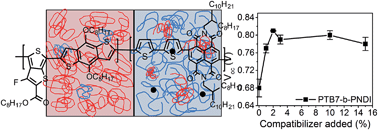Parallel bulk heterojunction photovoltaics based on all-conjugated block copolymer additives†
Abstract
In recent studies, we demonstrated that the addition of block copolymers to binary donor–acceptor blends represents an effective approach to target equilibrium, co-continuous morphologies of interpenetrating donors and acceptors. Here, we report a study of the impact of all-conjugated poly(thieno[3,4-b]-thiophene-co-benzodithiophene)-b-polynaphthalene diimide (PTB7-b-PNDI) block copolymer additives on the electronic properties and photovoltaic performance of bulk heterojunction organic photovoltaic active layers comprised of a PTB7 donor and a phenyl-C61-butyric acid methyl ester (PCBM61) acceptor. We find that small amounts of BCP additives lead to improved performance due to a large increase in the device open-circuit voltage (VOC), and the VOC is pinned to this higher value for higher BCP additive loadings. Such results contrast prior studies of ternary blend OPVs where either a continuous change in VOC or a value of VOC pinned to the lowest value is observed. We hypothesize and provide evidence in the form of device and morphology analyses that the impact of VOC is likely due to the formation of a parallel bulk heterojunction made up of isolated PCBM and PNDI acceptor domains separated by intermediate PTB7 donor domains. Altogether, this work demonstrates that all-conjugated block copolymers can be utilized as additives to both dictate morphology and modulate the electronic properties of the active layer.



 Please wait while we load your content...
Please wait while we load your content...